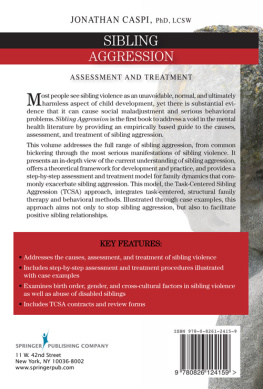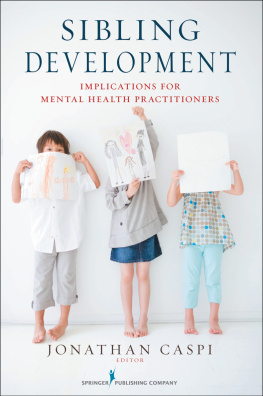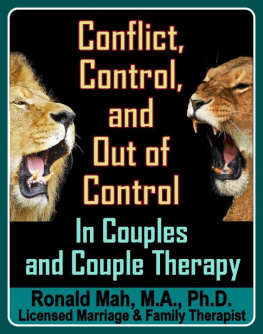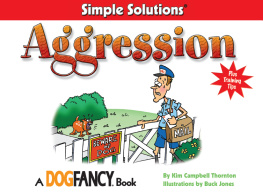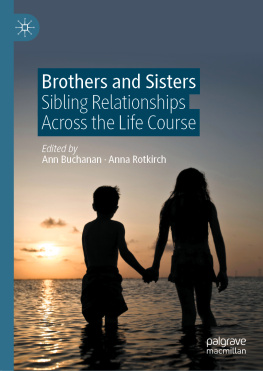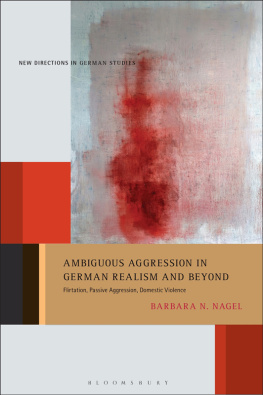Sibling Aggression
Assessment and Treatment
Sibling Aggression
Assessment and Treatment
Jonathan Caspi, PhD, LCSW, is Associate Professor and Graduate Program Coordinator in the Department of Family and Child Studies, Montclair State University, Montclair, New Jersey. His areas of scholarship include sibling process, sibling aggression, intervention development, and clinical supervision. Dr. Caspi teaches sibling relationships, child development, interpersonal relationships, and family counseling courses to graduate and undergraduate students. He maintains a small private practice that includes family counseling, clinical social work supervision, and parent consultation services.
Sibling Aggression
Assessment and Treatment
Jonathan Caspi, PhD, LCSW
Copyright 2012 Springer Publishing Company, LLC
All rights reserved.
No part of this publication may be reproduced, stored in a retrieval system, or transmitted in any form or by any means, electronic, mechanical, photocopying, recording, or otherwise, without the prior permission of Springer Publishing Company, LLC, or authorization through payment of the appropriate fees to the Copyright Clearance Center, Inc., 222 Rosewood Drive, Danvers, MA 01923, 978-750-8400, fax 978-646-8600, .
Springer Publishing Company, LLC
11 West 42nd Street
New York, NY 10036
www.springerpub.com
Acquisitions Editor: Jennifer Perillo
Composition: Techset
ISBN: 978-0-8261-2415-9
E-book ISBN: 978-0-8261-2416-6
11 12 13/ 5 4 3 2 1
The author and the publisher of this Work have made every effort to use sources believed to be reliable to provide information that is accurate and compatible with the standards generally accepted at the time of publication. The author and publisher shall not be liable for any special, consequential, or exemplary damages resulting, in whole or in part, from the readers use of, or reliance on, the information contained in this book. The publisher has no responsibility for the persistence or accuracy of URLs for external or third-party Internet Web sites referred to in this publication and does not guarantee that any content on such Web sites is, or will remain, accurate or appropriate.
CIP data is available from the Library of Congress
Special discounts on bulk quantities of our books are available to corporations, professional associations, pharmaceutical companies, health care organizations, and other qualifying groups.
If you are interested in a custom book, including chapters from more than one of our titles, we can provide that service as well.
For details, please contact:
Special Sales Department, Springer Publishing Company, LLC
11 West 42nd Street, 15th Floor, New York, NY 10036-8002
Phone: 877-687-7476 or 212-431-4370; Fax: 212-941-7842
Email:
Printed in the United States of America by Gasch Printing
For Barbara and Daniel, truly superb and loving parents
... but even better grandparents!
Dedicated to the memory of William J. Reid
Contents
Preface
The first time I came across a research article that claimed sibling violence to be the most prevalent form of interpersonal aggression and child maltreatment, I did not believe it. How could that be possible? I had been reading about families for years before I was presented with this information. How is it that I could have gone through college, graduate school, doctoral study, professional workshops, and agency trainings and not encountered any discussion of sibling aggression along the way?
Sibling aggression is an invisible social phenomenon. It has received little attention in the practice, development, and research literatures, despite solid evidence that it is widespread and harmful. Strangely, it has not been invisible in other domains. Sibling aggression themes are prevalent in personal, historical, pop culture, and religious narratives. Children often complain about the treatment they receive from siblings, and parents frequently voice frustrations about their children being at each other all the time. However, these narratives have not been viewed as overly problematic. The only exception is the abundance of self-help books on sibling rivalry available to parents, but even these tend to focus more on the annoyance of parents and not on the protection of children.
Indeed, sibling aggression is typically considered to be developmentally expected and normal. As a consequence, such behavior is viewed as mundane, typical, and not damaging or problematic. Yet, a growing body of research has demonstrated that sibling aggression is destructive, with considerable negative consequences. Moreover, it often rises to the level of abusea dangerous, widespread, and underdiagnosed form of maltreatment. The dominant view of sibling aggression as harmless promotes practice that avoids engaging in systematic sibling evaluation, and risks missed victimization and client safety. Even bickering, considered to be a fairly mild form of conflict, is disruptive to family life and negatively affects sibling relationships. Sibling aggression is not just a problem of childhood. It occurs throughout the life course and has been linked to an array of other social problems. In short, sibling aggression constitutes a serious social concern.
At the same time, siblings represent a valuable personal resource. This relationship is simultaneously if not paradoxically characterized by intense closeness and support (e.g., We are more than best friends, we are like sisters), and hostility. It is important that sibling aggression be stopped. It is equally important to preserve and develop positive sibling relationships, which are associated with many substantial benefits, including serving as a protective factor against unfavorable environmental conditions. Sibling relationships are a valuable source of strength and resilience, and need to be bolstered.
Practitioners receive little, if any, training about sibling aggressionas my own experience demonstrates. It is rarely included in university classes, practice curricula, or textbooks. Few interventions have been developed for this area of practice. Surprisingly, no current volumes offer clear practice guidelines for the full range of aggression. The time is ripe for such a book.
This book attempts to address current voids in the academic and professional literatures by offering a comprehensive volume that (a) provides an in-depth overview of current understandings of sibling aggression, (b) offers a new emerging sibling theory for development and practice, and (c) puts forth a coherent, empirically derived model that provides well-explicated series of steps and task strategies for the systematic treatment of sibling aggression, the Task-Centered Sibling Aggression (TCSA) treatment approach. TCSA integrates task-centered, structural family therapy and behavioral methods. It is a two-pronged approach that aims to stop aggression and facilitate positive sibling relationships.
This book should be of interest to a wide audience from a range of different backgrounds. First and foremost, it should be of great interest to clinical practitioners from the human service professions, including family therapy, social work, psychology, counseling, nursing, and family and child studies. Second, it should appeal to both graduate and undergraduate students and educators in these disciplines. Third, the book should be of interest to researchers who study siblings, family process, and treatment.

